Perfume making is an exquisite blend of art and science, capturing the essence of nature in a bottle.
The intricate process of perfume making, from the selection of raw materials to the final product, while uncovering the artistry that lies behind every fragrance.
The History of Perfume
The history of perfume dates back to ancient civilizations, where fragrant oils were used for ceremonies, personal adornment, and medicinal purposes. The Egyptians were among the first to develop the art of perfume making, utilizing natural ingredients such as flowers, herbs, and spices to create aromatic blends. As trade routes expanded, the knowledge of fragrance crafting spread to the Greeks and Romans, who refined the techniques further.
Understanding Fragrance Notes
At the heart of every perfume are its fragrance notes, which can be categorized into three main types: top notes, middle notes, and base notes.
1. Top Notes: They are typically light and volatile, often composed of citrus, fruity, or herbal aromas. Top notes provide the first impression of a fragrance but evaporate quickly, lasting only a short while.
2. Middle Notes: Middle notes form the core of the fragrance and usually consist of floral, spicy, or fruity elements. They last longer than top notes and help to define the character of the perfume.
3. Base Notes: Base notes, which include woody, resinous, and musky scents, linger the longest and can last for hours after application. Together, these three types of notes create a harmonious blend that evolves over time.
The Process of Perfume Making
The art of perfume making involves several steps, each requiring precision, creativity, and an understanding of scent chemistry. Here’s an overview of the key stages involved:
1. Sourcing Ingredients: The journey begins with sourcing high-quality raw materials, which can include essential oils, absolutes, and aroma compounds.
2. Creating a Formula: Once the ingredients are selected, the perfumer creates a formula by carefully blending different notes to achieve the desired scent profile. This process often involves experimentation, as the perfumer tests various combinations to find the perfect balance.
3. Maceration: After the formula is created, the mixture undergoes maceration, where the ingredients are allowed to blend and mature over time. This process can take several weeks to months, allowing the scents to develop and harmonize.
4. Filtration and Bottling: The final product is then bottled in carefully designed packaging that reflects the essence of the fragrance. The presentation of the perfume is an essential aspect of marketing, as it enhances the overall experience for consumers.
The Role of Perfumers
Perfumers, often referred to as noses, play a crucial role in the art of perfume making. These highly trained individuals possess an extraordinary sense of smell, allowing them to identify and differentiate between countless scents.
The Future of Perfume Making
Modern perfumers are increasingly embracing sustainable practices, using eco-friendly ingredients and packaging to meet consumer demand for greener products. Additionally, technological advancements in scent extraction and formulation allow for greater creativity and innovation in fragrance development.
The art of perfume making is a captivating journey that blends history, science, and creativity. Whether lykkers a fragrance enthusiast or simply curious about the world of scents, exploring the art of perfume making offers a fascinating glimpse into the creative process behind the fragrances we love!


